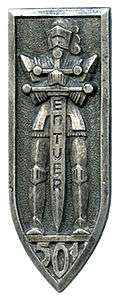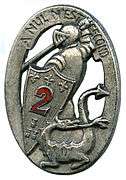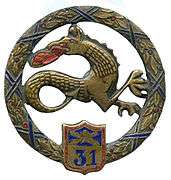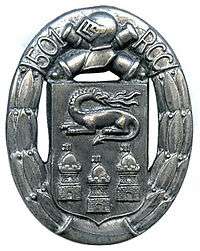501e Régiment de chars de combat
The 501e Régiment de chars de combat 501e RCC in French, (501e R.C.C, or 501st Combat Tank Regiment) is an armoured tank unit of the French Army created on May 13, 1918, and which took part in the two world wars, the Russian Civil War, the Indochina war, and the Algerian war.
| 501st Combat Tank Regiment | |
|---|---|
| 501e Régiment de chars de combat | |
 Regimental Insignia of the 501e RCC | |
| Active | 1918 – present |
| Country | |
| Branch | French Army |
| Part of | 2nd Armoured Brigade 3rd Division |
| Engagements | World War I World War II First Indochina War War on Terror (2001–present) |
| Battle honours |
|
| Commanders | |
| Notable commanders | Philippe Leclerc de Hauteclocque |
The regiment participated to the campaigns of Free France, then the liberation of Europe at the corps of the 2nd Armoured Division 2e DB of général Philippe François Marie Leclerc de Hauteclocque.
Merged with the 503e Régiment de chars de combat 503e RCC to form the 501e-503e Régiment de chars de combat 501e-503e RCC, the regiment was redesignated as 501e RCC on June 23, 2009.
Creation and different nominations
- 1916 : creation of the assault artillery.
- 1918 : creation of the 501st Special Artillery Regiment (French: 501e Régiment d'artillerie spéciale, 501e RAS).
- 1920 : became the 501e régiment de chars de combat 501e RCC.
- 1939 : the regiment became the 501st Tank Battalion Group (French: 501e Groupe de bataillons de chars, 501e GBC).
- 1940 : dissolution of GBC
- 1940 : 1st Tank company of Free France.
- 1943 : creation of the 501e RCC.
- 1944 : merged with the 503e RCC, was designated as 501e-503e RCC.
- 2009 : dissolution of GE 503, regiment redesignated as 501e RCC.
History
World War I
On April 16, 1917, 132 Schneider CA1 mount an assaut on Berry-au-Bac. Considered the first mounted tank assault in times. From this tank groupment, the 501st Assault Artillery Regiment (French: 501e Régiment d'artillerie d'assaut, 501e RAS.) was created on May 20, 1918.
the 501e RAS, designated RCC, would be the first unit formed with the new organization of the armoured troops in the beginning og 1918.
Initially composed of the first Groupment of Schneider tanks and of the 1st and 2nd battalions of light tanks, (the 1er and 2e BCL), created respectively on February 19 and March 18, 1918 and equipped with Renault FT. the 3rd battalion, formed on March 27, was initially assigned to the 508e Régiment de chars de combat 508e RCC then transferred to the 501e RCC since May 29, 1918.
Each light tank battalion was composed of three companies numbered from the 301.
Interwar period
The 501e was engaged in outre-mer at the corps of the army of the Orient. The 303rd Company of the 501st supported French and Greek forces around Odesa and Kherson, where they fought Nikifor Hryhorev's partisans.[1] On May 13, 1920, the 501 was designated as the 501e Régiment de chars de combat.
World War II
With the outbreak of the World War II, the regiment formed four combat tank battalions: the 1e and 2e BCC were respectively issued from the 1st and 2nd battalions of the 501e RCC and each comprised 45 Renault R35 tanks while the 30e and 31e BCC were respectively formed and equipped of 63 FT tanks from the reserves. While the 1e, 2e and 31e BCC remained at the corps of GBC 501 and were assigned to the Vth Army, the 30e BCC joined the GBC 502 of the IIIrd Army. These companies were engaged individually.
With the 342e autonomous company back from Narvik out of which a dozen of volunteers joined the Free France, the 1st autonomous tank company of Free France was formed.
The company later served within the ranks of the VIIIth British Army, equipped with British combat Crusader tank. This company was part of the "colonne volante" with the 1st Spahi Regiment.
Two other companies created in 1940 and 1941 merged then with the later to constitute a regiment (the regiment was articulated accordingly into four combat companies).
After having joined the United Kingdom with the 2nd Armoured Division 2e DB, in April 1944, the 501e embarked on August 3 to the Bancs de Grande Vey, on the north-east coast of Carentan. The regiment partook in the liberation of Paris, then Strasbourg and finished the events of campaign series engagements on May 5, 1945. The American command awarded the regiment, the « U.S. Presidential Unit Citation ».

1er BCC 
2e BCC 
31e BCC
1945 to present
Formed in September 1, 1945, a marching company embarked for Indochina.
The regiment was engaged in Central Europe, Senegal (1982), Lebanon (1984), Central African Republic (since 1985) and Yugoslavia.
On September 1, 1990, the chef d'état major de l'armée de terre CEMAT, created from the 4e Régiment de dragons 4e RD and the 503e Régiment de chars de combat, a regiment composed of 80 Leclerc tanks in two squadron groups (GE).
On August 31, 1994, the 501e Régiment de chars de combat was dissolved. Simultaneously, the squadron group of the 4e RD was designated squadron group 501. This evolution was remarked in the order of battle of the French Army, the 501e-503e Régiment de chars de combat.
On June 23, 2009, the 503 GE was dissolved and formed a fourth combat squadron in the corps of the 501e which became the 501e RCC. Accordingly, the regiment was integrated at the corps of the 2nd Armoured Brigade 2e BB.
Traditions
Insignia

Regimental Colors

Regimental Song
Dans le vent, la pluie et l'orage
Chevaux de fer monstres d'aciers canons pointés
Meilleur des chars toujours avec courage
Marche au combat sous les rafales avec fierté
Au 501 soyons toujours fidèles
De la DB les cœurs plus valeureux
Faisant flotter cette devise belle
Nous resterons toujours fiers et heureux
Prends garde aussi devant sa lunette
Un jour tu passe il restera trois secondes
Pour qu'a jamais ta propre vie s'arrête
Le béret noir t'envoie dans l'autre monde
L'éternité te sera moins pénible
Tu te diras ce n'est pas le hasard
C'est sans retour si l'on devient la cible
Du 501 toujours premier des chars
Au baroud après la bagarre
Si tu reviens avant de partir au pays
Tête levée pense à ton étendard
Car son serment d'Afrique n'a plus jamais trahi
Pense à celui qui reste sur la piste
Dans la fournaise le cœur dans sa tourelle
S'en est allé la haut vers les tankistes
Pour que la vie soit ici moins cruelle
Decorations
The regimental colors of the 501e RCC are decorated with:
- Croix de guerre 1914–1918 with :
- 2 palms titled to the 1st Light Tank Battalion of the 501st Special Artillery Regiment
- Croix de guerre 1939–1945 with:
- 2 palms
- Croix de la Libération.
- The regiment is entitled to bear wearing the fourragere with colors of the Croix de guerre 1914–1918 with olive colors of the Croix de guerre 1939–1945 and colors of the Croix de la Libération.
 Fourragere with colors of the Croix de guerre 1914–1918 and olive colors of the Croix de guerre 1939–1945.
Fourragere with colors of the Croix de guerre 1914–1918 and olive colors of the Croix de guerre 1939–1945. Fourragere with colors of the Ordre de la Libération.
Fourragere with colors of the Ordre de la Libération.
In 1939, six companies were entitled to wear the fourragere with colors of the Croix de Guerre 1914–1918. In total, 15 palms were awarded to six companies. Three companies of the 3rd battalion of the 501e RCC were awarded the fourragere cited at the orders of the Médaille militaire for four citations at the orders of the armed forces.
Honours
Battle Honours
- Aisne (1918)
- Soissonnais (1918)
- Champagne (1918)
- Belgique (1918)
- El-Alamein (1942)
- Paris (1944)
- Strasbourg (1944)
Regimental Commanders
|
(1918–1976)
|
|
|
GE 501 (1976–1994)
|
501e RCC (1994–present)
|
See also
References
- D. Bullock and A. Deryabin, Armored Units of the Russian Civil War: White and Allied, p. 13. Arthur Adams, Bolsheviks in the Ukraine, pp. 192-212 for the context.
Bibliographies
- Général Serge Andolenko, Recueil d'historique de l'arme blindée et de la cavalerie, Paris, Eurimprim, 1968.
- Adrien Bélanger, Auteur en autoédition - ISBN 2-9523027-1-5, 344 pages A5 - dépôt légal de septembre 2005 - Pour aller délivrer mes frères - Louis Michard (Chamblet, Allier [1914]- Grussenheim, Alsace [1945]- Compagnon de la Libération - 501e RCC de la 2e DB).
- 501e régiment de chars de combat. Le chemin le plus long Chronique de la compagnie de char de combat du général de Gaulle (1940–1945). (Éditions Maisonneuve & Larose)
- Avec les chars d'assaut Marcel Fourier. Hachette, 1919 (Témoins, p.|308-310)
- Sturmpionier - Passion histoire et militaria guerre 14-18. Au sommaire du numéro 52 (février/mars/avril 2011).
